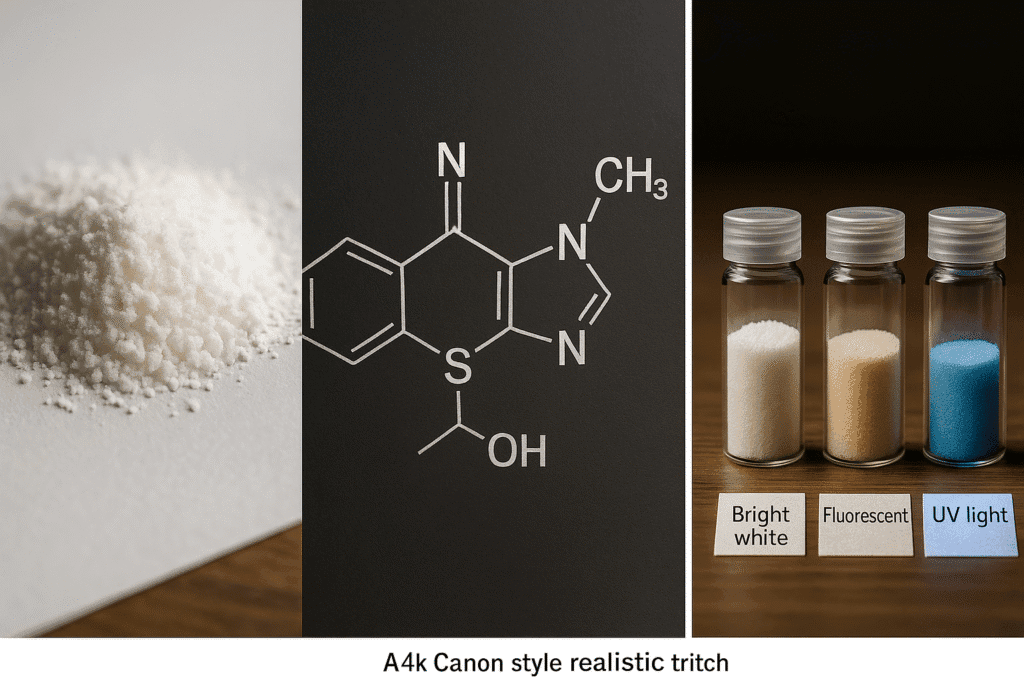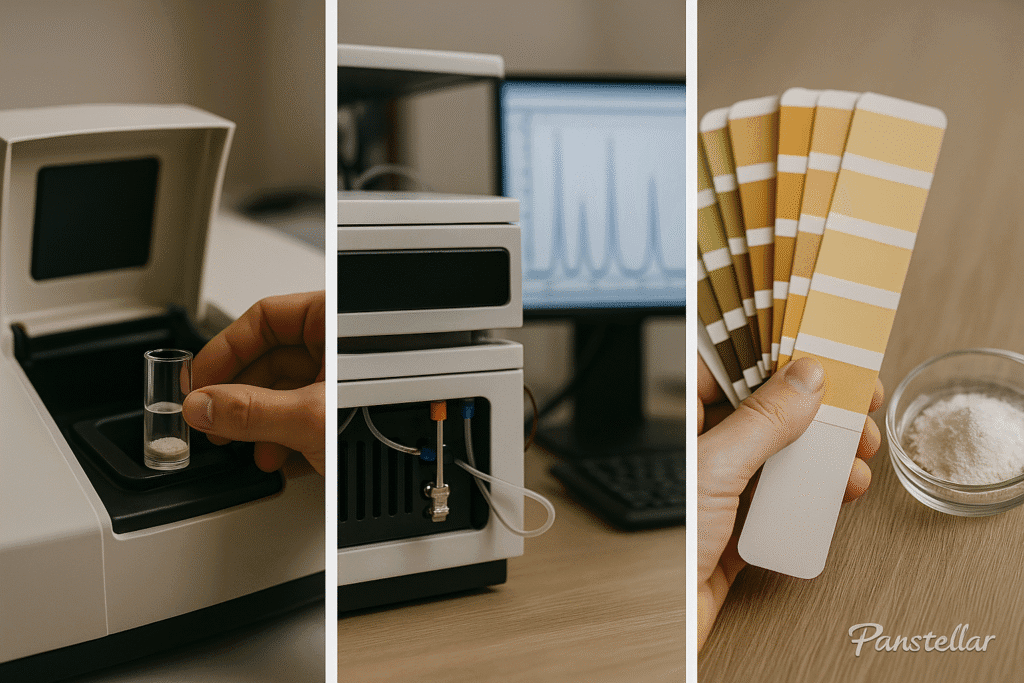Wondering if your fenbendazole is genuine? This powerful deworming medication has specific visual traits that reveal its quality and authenticity. As a pet owner, breeder, or animal care professional, knowing what pure fenbendazole looks like protects your animals and your investment. Our comprehensive visual guide breaks down fenbendazole’s appearance across different forms – from powder to tablets – so you can confidently identify quality products and avoid costly counterfeits.
I- Understanding Fenbendazole’s Natural Color and Appearance

Pure fenbendazole presents as a white to off-white crystalline powder. This characteristic color directly reflects its chemical composition and level of purity. The compound’s molecular structure—consisting of a benzimidazole ring system attached to a phenyl ring via a sulfur atom—contributes to its distinctive appearance.
When examining fenbendazole under different lighting conditions, you may notice subtle variations:
| Lighting Condition | Observed Color |
|---|---|
| Natural daylight | Bright white |
| Fluorescent light | Pale ivory |
| UV light | Faint blue fluorescence |
These visual properties serve as important quality indicators, particularly in professional and research settings where product purity is essential.
II- Identifying Fenbendazole in Different Formulations

Fenbendazole comes in various forms to accommodate different administration methods and animal species. Each formulation may present slightly different visual characteristics:
A- Powder Form
The powder formulation appears as a fine, white to off-white substance with a slightly granular texture. This is the purest visual form of fenbendazole and is commonly used for research purposes or to prepare custom dosages.
B- Liquid Suspensions
When formulated as a suspension, fenbendazole typically presents as a white to pale yellowish liquid with an opaque, milky appearance. The suspension may settle over time, creating a visible layering effect that requires shaking before use.
C- Tablet Form
Fenbendazole tablets are usually white or off-white, sometimes with a slight beige tint. These solid, compact forms may have specific markings or imprints depending on the manufacturer and dosage strength.
D- Paste Formulations
For easy administration to animals, particularly horses, fenbendazole is often formulated as a smooth, white to off-white paste with a consistent texture.
| Formulation | Color Range | Texture/Consistency |
|---|---|---|
| Powder | White to off-white | Fine, dry, crystalline |
| Suspension | White to pale yellow | Liquid, opaque |
| Tablet | White to beige | Solid, compact |
| Paste | White to off-white | Smooth, consistent |
III- Factors That Influence Fenbendazole’s Color
Several factors can affect the visual appearance of fenbendazole preparations:
A- Concentration Levels
Higher concentrations of fenbendazole typically result in more intense coloration. Products with lower concentrations may appear lighter or more translucent.
B- Purity and Manufacturing Process
The purity of the active ingredient significantly impacts color. Higher purity levels generally produce a lighter, more consistent shade. The manufacturing process, including particle size and crystal formation, also influences the visual characteristics.
C- Excipients and Additives
Commercial formulations often contain additional ingredients that may alter the appearance of the final product. These include binders, fillers, and occasionally colorants for product differentiation.
D- Environmental Conditions
Exposure to light, heat, and humidity can gradually change the appearance of fenbendazole products over time. Proper storage is essential for maintaining both visual consistency and therapeutic efficacy.
| Factor | Effect on Color |
|---|---|
| Concentration | Higher = Deeper hue |
| Purity | Higher = Lighter shade |
| Light exposure | May cause fading or yellowing |
| Humidity | Can affect consistency and color |
IV- Using Color as a Quality Indicator
The visual characteristics of fenbendazole can serve as valuable indicators of product quality and stability. As this medication undergoes chemical changes, its appearance may shift from a pristine white to various shades of yellow or brown—signaling potential degradation.
A- What Color Changes May Indicate
| Color | Potential Implication |
|---|---|
| White | Optimal condition |
| Pale yellow | Minor degradation or age |
| Dark yellow/brown | Significant deterioration |
For veterinary professionals and pet owners, these visual cues can provide important information about medication quality. While slight color variations between batches may be normal, significant color changes in the same product could indicate quality issues.
V- Professional Methods for Analyzing Fenbendazole Color

In professional and research settings, several analytical techniques are used to assess fenbendazole’s color characteristics:
A- Spectrophotometry and Colorimetry
These techniques measure the absorption and reflection of light at specific wavelengths, creating precise color profiles for each sample. This approach is particularly useful for quality control in pharmaceutical manufacturing.
B- High-Performance Liquid Chromatography (HPLC)
When coupled with a diode array detector, HPLC allows for the separation and identification of individual components that contribute to fenbendazole’s overall appearance.
C- Visual Comparison Methods
Using standardized color charts or digital imaging software, analysts can evaluate fenbendazole samples against established benchmarks—a practical approach for field assessments.
VI- Practical Tips for Visual Identification
For veterinarians and pet owners, these practical guidelines can help with the visual identification of quality fenbendazole products:
- Check the manufacturing date and expiration: Fresher products typically maintain their original color better.
- Examine under good lighting: Natural daylight provides the most accurate color assessment.
- Compare to reference images: Familiarize yourself with how quality fenbendazole should appear.
- Be wary of unusual colors: Pure fenbendazole should never appear gray, pink, green, or other non-white/off-white colors.
- Consider packaging integrity: Damaged packaging may have allowed environmental exposure that affected the product’s appearance.
Conclusion
Understanding the visual properties of fenbendazole provides valuable insights for anyone working with this veterinary medication. The color and appearance serve as important indicators of quality, purity, and stability. By familiarizing yourself with how fenbendazole should look in its various forms, you can make more informed decisions about the products you use or recommend.
Whether you’re a veterinary professional assessing medication quality or a pet owner wanting to ensure you’re administering a proper product, this visual guide offers practical knowledge for fenbendazole identification.
Disclaimer: This article is for informational purposes only. Always consult with a qualified veterinarian before administering any medication to animals.
References
Fenbendazole: A Review of Its Veterinary Use – National Center for Biotechnology Information
Physical and Chemical Properties of Benzimidazole Anthelmintics – PubMed Database
Quality Control Methods for Veterinary Pharmaceuticals – ScienceDirect
Analytical Methods for Fenbendazole Determination – Springer Link
Stability Studies of Anthelmintic Drugs – Taylor & Francis Online
FDA Guidance for Veterinary Drug Identification – FDA Center for Veterinary Medicine
Pharmaceutical Analysis by HPLC Methods – Wiley Online Library
Visual Inspection Methods in Pharmaceutical Quality Control – American Pharmaceutical Review
Counterfeit Veterinary Medicines: A Growing Concern – Veterinary Record
Spectrophotometric Analysis of Pharmaceutical Compounds – Elsevier Spectrochimica Acta
